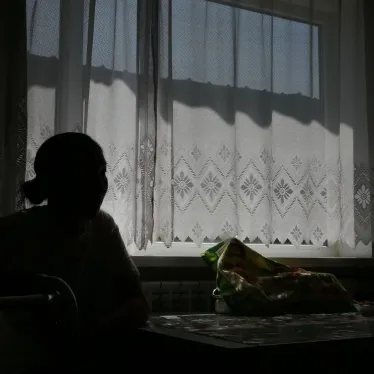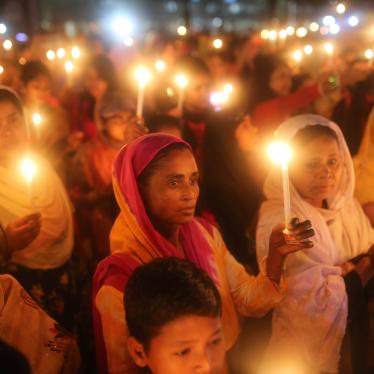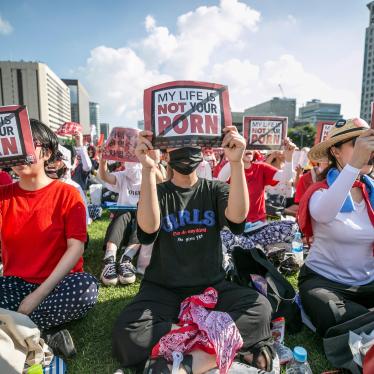Submission to Lumos regarding the links between children’s institutional care and education
Human Rights Watch welcomes the opportunity to provide input to Lumos’ “Global Call for Evidence on the links between Children’s Institutional Care and Education.” From 2014-2021, Human Rights Watch has documented the relationship between institutional care and education in in-depth research reports on Armenia, Brazil, Kazakhstan, Kyrgyzstan, Russia, and Serbia.[1]
Armenia
In 2017, Human Rights Watch published a report on institutions and access to education for children in Armenia. Our research found that children with disabilities living in state orphanages overwhelmingly received limited education inside the orphanage, attended segregated special schools, or in some cases received no education at all. Very few attended mainstream inclusive schools. Those who did attend schools outside the orphanage went for a shortened day.[2]
In contrast, children without disabilities living in orphanages attended community schools.
Human Rights Watch’s research indicates that since 2017, the government of Armenia has significantly reduced the number of children in state-run residential orphanages, night-care institutions, and residential special schools, and supported children to return to their families or to live with foster families.[3] However, the government has no plan to transform or close three orphanages for children with disabilities, and as a result there are serious risks that children with disabilities in those institutions will continue to be deprived of a quality inclusive education.[4]
On the other hand, we acknowledge that the government continues its efforts to expand and improve inclusive education across the country, which is important for ensuring children with disabilities remain with their families in their communities, rather than live in an institution in order to access essential services, such as education. According to UNICEF, the Armenian government aims to transform the remaining special schools into resource centers to provide guidance, training, and educational resources to schools across the country that would support children with disabilities to remain in their communities and attend mainstream schools.[5] To expand community-based services to children and families, the government has already transformed several institutions into Child and Family Support Centers, which include daycare services, or Regional Pedagogical-Psychological Support Centers, which have a focus on education. These services may be important to prevent institutionalization and ensure children can remain at home, in their families, with access to education in their communities.[6]
Brazil
Human Rights Watch research in 2017-2018 on institutionalization of adults and children with disabilities in Brazil, based on visits to 19 institutions, found that most children with disabilities in institutions for people with disabilities, do not go to school. This was particularly true for those with intellectual disabilities or high support requirements. In institutions visited by Human Rights Watch, the institution’s staff typically determined whether the child would receive an education or not.[7]
Only children whom the institution staff determined had some level of autonomy attended school. Children with disabilities living in general institutions or without intellectual disabilities did attend local mainstream schools in local communities. In some cases, children from institutions also attend segregated special schools outside the institution. Some institutions provide children with intellectual or sensory disabilities special education programs within the institution, which has no official status as an educational facility. Children receive a certificate that is not an official diploma and would not allow an individual to continue his or her education elsewhere. Human Rights Watch observed many children with disabilities in institutions had few or no meaningful activities and were observed lying in bed doing nothing or were placed in front of a television for hours on end.[8]
A São Paulo’s Public Prosecutor’s Office’s inquiry in 2016 into 16 institutions for children with disabilities in the municipality found that two-thirds of the institutions had no relationship with any educational services.[9]
Kazakhstan
Human Rights Watch research in 2018 for a 2019 report on access to education for children with disabilities found that the overwhelming majority of children institutionalized in neurological-psychiatric institutions for children with an intellectual or psychosocial disabilities did not receive any education at all. For example, in one psychiatric-neurological institution Human Rights Watch visited in November 2018, only 12 of 131 children received education, and the education provided was in the facility. Until September 2018, no children received any education, according to the staff.[10]More than 2,000 children live in these types of children’s institutions in Kazakhstan, although many have at least one living parent.[11]
As part of the research, Human Rights Watch corresponded with the Kazakhstan government. In a November 2018 letter to Human Rights Watch, the government stated that children with disabilities in psychoneurological institutions, which are part of the social services system, did not receive education. Staff at institutions visited by Human Rights Watch as well as young people who grew up in these institutions and parents of children with disabilities who have been in these institutions interviewed by Human Rights Watch confirmed the absence of education.[12]
For example, a former resident of one such institution in Kazakhstan, now 24, told Human Rights Watch that he did not get any education at all: “I didn’t go to school. They didn’t teach us anything. They won’t let me study now because of my age.” “Tanya,” (not her real name) another former resident, told Human Rights Watch that a teacher would come to the institution several times a week when she was in the first and second grade, but then stopped coming altogether. “For some time, I studied, but then they closed [the program]. I don’t know what happened,” Tanya said. “I wanted to keep studying, but there was no chance.” Tanya said that she did not receive any formal school education since then.
Parents interviewed by Human Rights Watch reported that they may feel compelled to place their child in an institution when they faced barriers in accessing mainstream schools or essential services. [13]
Human Rights Watch interviewed “Zhemis” (not her real name), the mother of “Kanat” (not his real name), a 16-year-old boy with cerebral palsy and a wheelchair user. Zhemis placed her son into an institution when she was no longer able to provide care at home. She told Human Rights Watch that her son receives support from a social pedagogue who helps with life skills, but “Kanat” doesn’t receive an education, “… He doesn’t get any real lessons unfortunately.” [14]
Human Rights Watch also interviewed “Antonia” (not her real name), the mother of 10-year-old twins with autism, who placed her children in a neurological-psychiatric institution, after a kindergarten official refused to admit the children, incorrectly claiming that an official document approving their enrollment was required. In the institution, the twins did not receive any education. “Antonina” told Human Rights Watch, “I took them there for half a year. There was one room, for 20 children… Hyperactive children are given pills [to make them calmer]. [The children] don’t do anything. They just stare into space… They spend all day there. At maximum they go to the dining hall or toilet. There are only two caregivers... No one does any lessons with them. Maybe the psychologist for 15 minutes.” [15]
Kyrgyzstan
A December 2020 Human Rights Watch report found that some parents of children with disabilities felt compelled to place their child in a residential institution, above all due to barriers to education in mainstream schools in their communities. Parents described discrimination on the part of school officials who refused to enroll their children. They also described how schools are often physically inaccessible and may fail to provide an individualized approach or reasonable accommodations to learners with disabilities. Approximately 3,000 children with disabilities in Kyrgyzstan are segregated in residential institutions or special schools where they face neglect and discrimination.[16]
Children with disabilities living in psychoneurological institutes in Kyrgyzstan have no access to education and no formal schooling. Staff said that children entering these institutions were automatically deemed unfit for education. In two psychoneurological institutions visited by Human Rights Watch, staff or volunteers organized small “classes” for a few children selected by the staff. Only one child in either of the two institutions, which together held nearly 300 children, studied outside its perimeters. One boy with cerebral palsy traveled to a private school every day.[17]
In interviews with Human Rights Watch, five young people who had previously lived in institutions said they had received virtually no schooling in these institutions and had no opportunity to attend mainstream or special schools outside of the institution. They were not taught to read or write, despite the fact that upon leaving the institution, or in some cases independently while in the institution, they learned to do so. The interviewees said only two or three hours a day were devoted to informal lessons, which were typically conducted by caretakers, not professional teachers.[18]
Parents also expressed concerns about the quality of education in segregated residential special schools.[19]
Russia
In 2013, Human Rights Watch visited ten orphanages in six regions in Russia and conducted over 200 interviews with parents, children, and young people who either lived or previously lived in institutions for children with disabilities. Children with disabilities living in these facilities had little or no access to education. The children who receive an education do so within the institution’s walls, rather than in the community alongside other children. Children with high support needs were confined to “lying-down” rooms, where staff forced them to remain in cribs their entire lives. One state orphanage attempted to provide 100 out of approximately 400 children with disabilities access to education in community-based specialized schools. The stigma towards the institutionalized children was so great that these children were required to study in separate classrooms and on a separate schedule. [20]
Our research found that the lack of government-provided services, such as inclusive education, accessible rehabilitation, and other forms of support that would enable families to raise children, all contribute to Russia’s high rate of institutionalization of children with disabilities.[21]
Serbia
According to the most recent Serbian government data, in 2019, 73.9 percent of children in institutions were children with disabilities.[22] Human Rights Watch research in 2015 and 2016 found that young people with disabilities living in institutions had limited access to education and the vast majority of them were not enrolled in schools. Children who did receive education attend specialized schools exclusively for children with disabilities. In some cases, teachers visited institutions to teach children in groups for a few hours a day.[23]
[1] Human Rights Watch, “When Will I Get to Go Home?: Abuses and Discrimination against Children in Institutions and Lack of Access to Quality Inclusive Education in Armenia,” (New York: Human Rights Watch, 2017), https://www.hrw.org/report/2017/02/22/when-will-i-get-go-home/abuses-and-discrimination-against-children-institutions; “They Stay until They Die: A Lifetime of Isolation and Neglect in Institutions for People with Disabilities in Brazil,” (New York: Human Rights Watch, 2018); “On the Margins: Education for Children with Disabilities in Kazakhstan,” (New York: Human Rights Watch, 2019), https://www.hrw.org/report/2019/03/14/margins/education-children-disabilities-kazakhstan; “Kazakhstan: Children in Institutions Isolated, Abused,” Human Rights Watch news release, July 17, 2019, https://www.hrw.org/news/2019/07/17/kazakhstan-children-institutions-isolated-abused; “Insisting on Inclusion: Institutionalization and Barriers to Education for Children with Disabilities in Kyrgyzstan,” (New York: Human Rights Watch, 2020), https://www.hrw.org/report/2020/12/10/insisting-inclusion/institutionalization-and-barriers-education-children; “Abandoned by the State: Violence, Neglect, and Isolation for Children with Disabilities in Russian Orphanages,” (New York: Human Rights Watch, 2014), https://www.hrw.org/report/2014/09/15/abandoned-state/violence-neglect-and-isolation-children-disabilities-russian; “It is My Dream to Leave This Place: Children with Disabilities in Serbian Institutions,” (New York: Human Rights Watch, 2016), https://www.hrw.org/report/2016/06/08/it-my-dream-leave-place/children-disabilities-serbian-institutions.
[2] Human Rights Watch, “When Will I Get to Go Home?: Abuses and Discrimination against Children in Institutions and Lack of Access to Quality Inclusive Education in Armenia.”
[3] Human Rights Watch telephone interview with disability rights activists, Yerevan, May 14, 2021.
[4] The three orphanages for children with disabilities which have not been included in the government’s deinstitutionalization plans are the Mariz Izmirlyan, Kharberd, and Gyumri specialized orphanages. Human Rights Watch telephone interview with disability rights activists, Yerevan, May 14, 2021, and Human Rights Watch, “When Will I Get to Go Home?”
[5] Human Rights Watch, “Children’s Rights and Alternative Care,” Submission to the UN Committee on the Rights of the Child,” June 30, 2021, https://www.hrw.org/news/2021/06/30/childrens-rights-and-alternative-care.
[6] Human Rights Watch telephone interview with disability rights activist, Yerevan, May 14, 2021.
[7] Human Rights Watch, “They Stay until They Die: A Lifetime of Isolation and Neglect in Institutions for People with Disabilities in Brazil.”
[8] Ibid.
[9] São Paulo Public Prosecutor’s Office, Civil Inquiry no. 033/2017, vol. 1, p. 97, on file with Human Rights Watch.
[10] Human Rights Watch, “On the Margins: Education for Children with Disabilities in Kazakhstan.”
[11] Ibid.
[12] Ibid.
[13] Ibid.
[14] Ibid.
[15] Ibid.
[16] Human Rights Watch, “Institutionalization and Barriers to Education for Children with Disabilities in Kyrgyzstan.”
[17] Ibid.
[18] Ibid.
[19] Ibid.
[20] Human Rights Watch, “Abandoned by the State: Violence, Neglect, and Isolation for Children with Disabilities in Russian Orphanages.”
[21] Ibid.
[22] Human Rights Watch, “Children’s Rights and Alternative Care,” Submission to the UN Committee on the Rights of the Child,” June 30, 2021.
[23] Human Rights Watch, “It is My Dream to Leave This Place: Children with Disabilities in Serbian Institutions.”








